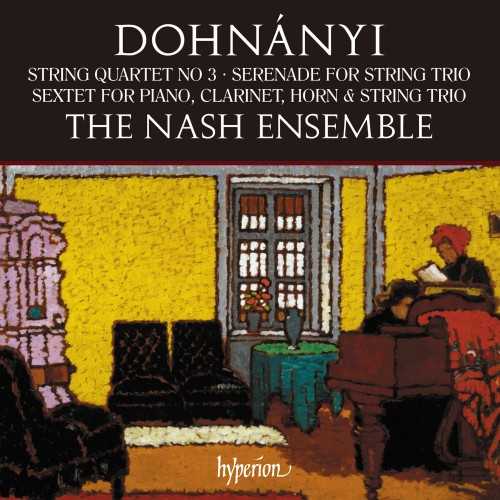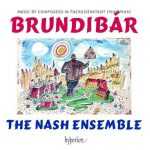
Composer: Ernő Dohnányi
Performer: Nash Ensemble
Audio CD
Number of Discs: 1
Format: FLAC (tracks)
Label: Hyperion
Size: 1.34 GB
Recovery: +3%
Scan: yes
Serenade for string trio in C major Op 10
01. 1. Marcia: Allegro
02. 2. Romanza: Adagio non troppo
03. 3. Scherzo: Vivace
04. 4. Tema con variazioni: Andante con moto
05. 5. Finale: Rondo
String Quartet No 3 in A minor, Op 33
06. 1. Allegro agitato e appassionato
07. 2. Andante religioso con variazioni
08. 3. Vivace giocoso
Sextet for piano, clarinet, horn and string trio in C major, Op 37
09. 1. Allegro appassionato
10. 2. Intermezzo: Adagio
11. 3. Allegro con sentimento –
12. 4. Finale: Allegro vivace, giocoso
The Nash Ensemble:
Stephanie Conley – violin I
Laura Samuel – violin II
Lowrence Power – viola
Adrian Brendel – cello
Ian Brawn – piano
Richard Hosford – clarinet
Richard Watkins – horn
The music of Dohnányi (admired by figures as disparate as Brahms and Bartók) embodies virtues of taste, humour, impeccable control of form and beauty of style; all qualities relished by The Nash Ensemble in wonderful new recordings which can only assist with this composer’s continuing rehabilitation.
Founded in 1964, the Nash Ensemble is one of Britain’s—if not the world’s—longest-lasting chamber ensembles and certainly one of the most active both in live and recorded performances. They have presented 300 new works, many of which have been specially written for them, while their discography lists almost 100 recordings of music ranging from Mozart to MacMillan, and includes substantial additions to the recorded catalogues of Beethoven, Brahms and Schubert chamber works. What ensures the survivability of the Nash Ensemble in an age when new chamber groups of ever-increasing virtuosity have been popping up all over the place, and both standards of music making and public tastes for chamber music have undergone dramatic transformations, is their great flexibility. This is not just flexibility in repertory—they seem able, willing and eager to handle anything going—but a flexibility of size; they have a unique ability to call on outstanding players of almost every conceivable instrumental discipline. From their core group, this disc makes use of the string quartet (Stephanie Gonley, Laura Samuel, Lawrence Power and Adrian Brendel), two wind players (clarinettist Richard Hosford and hornist Richard Watkins) and pianist Ian Brown. But perhaps even more than their ability to tackle a vast repertory and their enormously flexible instrumental line-up, what has characterised everything the Nash Ensemble has done since their very earliest days is a sense of absolute joy in music making and a passion which glows out of every single note they play. If we might reasonably expect a certain predictability to have crept into their performances after half-a-century at the very top of their game, nothing could be further from the truth with this invigorating and gloriously immersive journey through three very different chamber works by Ernö Dohnányi.
The booklet notes claim that the music of Dohnányi ‘disappeared completely’ from the repertory in the decades between his death and the end of the 20th century, but that is simply not true. Throughout those years his reputation as a composer was sustained largely through his mischievous Variations on a Nursery Theme, and while that work may have gone out of fashion, the wit and humour which made it so hugely popular for a time is very much to the fore in the Serenade which begins this first recording by the Nash Ensemble of Dohnányi chamber music. The perky first movement is given a lovely buoyancy by Brendel’s delicate pizzicato and by much rhythmic vitality from the other two players, sending out a firm signal that here is Hungarian music in the mould of Bartók and Kodály. This is music with a spring in its step and sunshine in its heart—even the somewhat Tchaikovskian fourth movement theme and variations seems to be holding its smile at bay as it pays lip service to pathos—and the final movement sees the three players romping home with the same playful energy as you see when new-born lambs are gambolling in the sunshine on a bright spring day.
If the Serenade is light and breezy, the Third String Quartet is a work of great emotional intensity and occasional austerity, and this is a simply matchless performance of it. The first movement is magnificently measured moving from the agitated nervousness of the opening to the full-blown aggression of the war-like march at 4:24. In the chorale theme of the second movement, the Nash Ensemble exudes a statuesque calm and a breadth of vision which effectively counters the squeezed edginess of the first movement. Nevertheless, moments reminiscent of English pastoral music are soured by Dohnányi’s characteristic harmonic palette, and the music breathes an atmosphere which feels very much like the calm before a storm. There is a tantalisingly delicate rainstorm with the second variation (3:36)—a model of collective delicacy from the players—but the real storm comes with the tempestuous third movement, played here with superb energy and control, breezing over the unexpected harmonic twists and turns and broken melodic fragments and coalescing it all into a purposeful and exhilarating whole. I am particularly taken by the almost sensuous chromatic slides in the central section (2:00) and the unforced syncopated rhythms here, and by the gloriously assertive way in which they end the work.
The Sextet churns into action with propulsive momentum set up by the piano, and proceeds to indulge in the kind of opulent late-romanticism strongly reminiscent of Richard Strauss—something enhanced by the presence of the horn in the ensemble. Unexpected changes of speed, direction and mood abound, yet here is a performance which embraces them all with a kind of openness which makes this a hugely attractive piece of music-making. After a richly expressed opening, the funeral march of the second movement (1:27) finds Brown stabbing out the march-like chords while wind and then strings proclaim with growing intensity a gloriously arching theme. Here the Nash Ensemble is at its very best, creating a compelling interpretation through impeccable unity of approach. Typical of Dohnányi, this idea does not last long, but as it evolves into something altogether more luminous, the Ensemble carries the transformation along without blinking the eye—it all flows so naturally, the contours of the music beautifully traced as a continuous whole rather than a series of unconnected ideas. A graceful clarinet solo opens the enchanting third movement, the string accompaniment beautifully responsive to Hosford’s lyrically poised playing. And so to the unforgettably jolly finale with its mischievously catchy tune taken up at various times by all six instruments and thrown around a whole plethora of keys and harmonisations. This is all huge fun, at one point breaking into a spoof-Viennese waltz and at another throwing in a lovely bit of canonic writing, and it is all brilliantly played. It makes for utterly and completely compelling listening.



